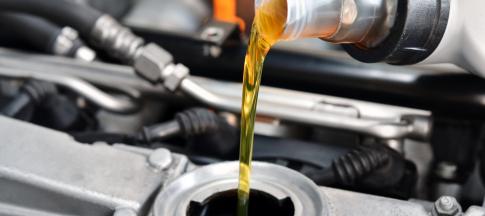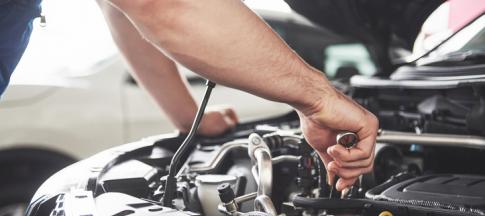
Our MOT testing guide discusses what one is, what to do before, during and after one, as well as how to avoid common MOT fails.
What’s an MOT?
MOT stands for Ministry of Transport, and it’s for an annual test that checks your vehicle meets road safety and environmental standards.
Some historic classic cars are exempt from MOTs, which you can read about in our classic car MOT guide.
When will a car need its first MOT?
A car needs its first MOT when it's three years old.
After that, it’ll need an MOT on the anniversary of its last MOT, as long as it’s over three years old.
Some vehicles need testing after being one year old. Refer to the government’s MOT fees table to see which.
Before the MOT
The documents you need
You’ll need your:
- V5C logbook, if it’s your first one or your number plate has changed
- driving license
The mechanic could find your vehicle details without a V5C, but bring it just in case.
Booking one
You should book your MOT with an approved garage around a month before it runs out. For example, if your MOT runs out on February 15th, the earliest you can book is January 16th.
Book at an approved garage – you can usually do it online, over the phone or in person. Only centres with a blue sign with three white triangles can do it.
Pre-MOT Checklist
Here are five effective things you can do at home before your MOT:
- Clean out the clutter from your vehicle – an examiner can refuse to carry out the MOT if your vehicle is excessively dirty or filled with rubbish.
- Check your horn works – a broken horn can lead to a failed MOT, so give it a honk before you go.
- Clean your number plates – both the front and back number plates must be readable to pass.
- Make sure ALL lights work – check your headlights, tail lights, sidelights, indicators, brake lights, registration plate lights, fog lights and hazard lights and replace them if broken.
- Top up all fluids – your screen wash and brake fluid should be topped up to avoid a failed MOT.
During MOT
What does an MOT test cover?
An MOT looks at several areas of your car:
- brakes
- fuel system
- lights
- seatbelts
- windscreen wipers
- exhaust
It doesn’t look at the condition of your:
- engine
- gearbox
- clutch
How much does an MOT cost?
The UK government caps MOT costs depending on the category. Garages don’t have to charge the full amount, with many staying competitive by charging less. Below are the charges for common vehicle MOTs:
- an MOT for vehicles up to 3,000kg gross weight and cars up to eight passenger seats (class 4) is capped at £54.85.
- an MOT for good vehicles (usually vans) from 3,000kg to 3,500kg gross weight (class 7) is capped up at £58.60.
For more information, check the government MOT fees.
After MOT
Understanding MOT results
You either pass or fail an MOT. However, there are four additional results that tell you why you passed or failed, as well as providing additional information.
- Dangerous - this is an automatic fail. It means your car has one or more significant safety risks. It needs immediate repair.
- Major – this is an automatic fail. They aren’t considered as severe as dangerous, but they could pose a safety risk. It needs immediate repair.
- Advisory – this is a minor issue. It doesn’t need immediate repair, but it could become dangerous in future.
- Pass – this means your car is roadworthy and safe to drive.
What happens if you fail an MOT
It depends on if you have dangerous, major, minor or advisory problems in your results. You can’t drive until you fix dangerous or major problems.
If your car fails an MOT, you’ll get a refusal of an MOT test certificate, which the garage will record in the MOT database.
You have a right to appeal the result.
Common MOT fails
Now you know when your MOT is, what happens if you don’t have a valid certificate and quick ways to prepare for an MOT, here are common fail-points and how to prevent them.
Tyres
To avoid failing your MOT, you should check your tyre pressure against your manufacturer’s instructions, filling them up if needed to improve handling and braking performance.
You should also check for uneven wear which could indicate a steering fault and affect your vehicle’s ability to grip the road.
If one tyre regularly drops pressure, get it checked by your local garage or tyre specialist as it may have a nail or other object in the tread. Look for splits, tears or bulges in the sidewalls as it may be a slow puncture too.
Check your tread depth by placing a 20p coin into the main tread. If you can see the outer border, your tyre is either approaching or has already reached the legal limit of 1.6mm, and you’ll need to replace it.
While the legal limit is 1.6mm, 3mm is recommended for driving safely.
Learn more about getting the right tyres for your vehicle.
Wipers
Inspect the wiper blades physically. If they’re torn or badly worn, causing streaks when in operation, it’s a fail. Replacing broken windscreen wipers may seem daunting, but it’s usually a quick DIY job and can be bought from plenty of car accessory suppliers.
If you don’t feel comfortable changing your windscreen wipers, you can pay someone at a local garage to do it for you. Ask them to show you while they do it so you feel confident about any future changes.
Windscreen
If your windscreen has any chips or cracks, you may be covered by your car or van insurance policy. However, repairs or replacements must be completed before the test date.
Engine management / Airbag warning lights
If your lights are illuminated this might cause your vehicle to fail the test. It’s not usually a DIY fix, so book into your local garage for diagnosis and a repair when possible.
Brakes
Callipers, cables and other components under the vehicle can be damaged by dirt and corrosion, and discs and brake pads or shoes can quickly wear to an unacceptable thickness.
Get your brakes checked if:
- the brake warning light is illuminated on your dashboard
- your car is pulling to one side
- you hear a high-pitched or metal grinding sound
- you can smell burning carpet
- you feel vibrations and changes in footbrake pedal sensitivity
Suspension
Your vehicle's suspension makes sure you can drive safe and smooth. It absorbs the energy from road bumps to improve your control while driving.
Signs your suspension may need a service:
- reduced ride comfort and smoothness
- excessive body roll
- pulling to the left or right
- uneven tyre wear
- knocking noises when driving, particularly on uneven road surfaces
Exhaust, fuel and emissions
An MOT includes a professional emissions test, but you can check noise levels from your exhaust and any excessive smoke.
If you think you have an issue, your local fastfit company can carry out a diagnosis and fit new sections as required, possibly at a lower cost than the garage carrying out your MOT.
A visibly smoking exhaust can indicate a number of issues, some minor, others more major. This is something you really need professional advice on.
Other ways to avoid a failed MOT
Look at last year’s advisories
Remember those ‘advisory’ items on last year’s pass certificate? No? Well now’s the time to take a look and see what potential concerns the tester spotted.
Unless you’ve had any rectification work done the potential issues will still be there and could well have got worse.
A warning about worn brake discs and pads? Get a local specialist to check them out and replace them if necessary.
Servicing
Although it’s another day off the road, a full service perhaps a few weeks before the test may well identify any potential issues, allowing you the opportunity to get them sorted prior to the MOT appointment.
A good technician will point out any areas of concern and discuss with you the options available.
When defects are picked up at the MOT, you’re on the back foot – you need the car or van back quickly, with a pass certificate and you might not have the opportunity to have the rectifications carried out the most economical way.
Vehicle MOT rules and costs
Driving your vehicle or parking on the road without a valid MOT is illegal and could invalidate your motor insurance.
Many people believe that there’s a 14-day grace period, but this is untrue and if caught, you can be fined up to £1,000. This fine increases to £2,500, plus penalty points, if you’re knowingly driving a dangerous vehicle.
If you’re unsure when your MOT is due, you can use the government MOT checker. You can also sign up for the free MOT reminder service where you'll get a text or email one month before your car, van or motorbike is due for its MOT.
If you’ve forgotten to renew your MOT, you can legally drive to a local test centre. But this must be reasonably close and if stopped by the police you need to prove where you're driving to.
I started my career selling vans in the mid-eighties, progressing through dealer groups to management level. In 2010 I joined vehicle valuation company CAP, being made responsible for forecasting future used values for all makes and models of vans and trucks, this data being used by leasing companies and manufacturers to assess future risk. This role entailed very early exposure to new models including extensive testing across Europe.
In 2016 I started up my own consultancy business dedicated to the LCV industry. In addition, my freelance written work has been used by a number of clients and I am a regular contributor to WhatVan? magazine. I’m also a judge for their annual ‘Van of the Year’ awards.
To relax, I enjoy travel and walking near my Yorkshire home.



